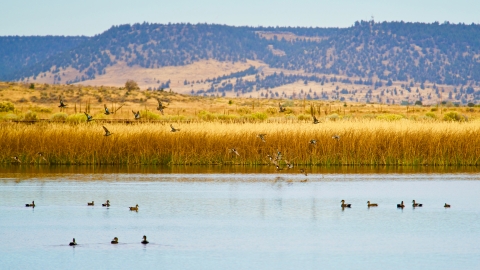About Us
The 7,021-acre Modoc NWR is located along the South Fork of the Pit River in Modoc County, southeast of the town of Alturas, in extreme northeastern California.
The refuge is located on the western edge of the Great Basin, a high elevation, cold desert environment. The refuge consists of wetland, reservoir, riparian riparian
Definition of riparian habitat or riparian areas.
Learn more about riparian , sagebrush sagebrush
The western United States’ sagebrush country encompasses over 175 million acres of public and private lands. The sagebrush landscape provides many benefits to our rural economies and communities, and it serves as crucial habitat for a diversity of wildlife, including the iconic greater sage-grouse and over 350 other species.
Learn more about sagebrush -steppe, and cropland habitats.
The refuge is part of a larger complex of mid-elevation wetlands and lakes of northeastern California and is strategically situated to meet the needs of waterfowl and other migratory birds of the Pacific Flyway. Modoc NWR acts as a migration and staging area for ducks, geese, and other wetland birds on the southward migration funnel into this region. After feeding and resting on the refuge, they continue to the Central and Imperial Valleys of California and other wintering areas. This pattern is reversed in the spring. The refuge’s wetlands and adjacent uplands are also an important nesting area for ducks, geese, greater sandhill cranes, and several other species of marsh birds.
Our Mission
Every National Wildlife Refuge has a defined vision that helps guide management. Here is Modoc NWR’s vision statement:
“Located near the confluence of the north and south forks of the Pit River, Modoc National Wildlife Refuge will conserve, restore, protect, and manage a mosaic of seasonal wetlands, semi-permanent wetlands, wet meadows, riparian riparian
Definition of riparian habitat or riparian areas.
Learn more about riparian , and sagebrush sagebrush
The western United States’ sagebrush country encompasses over 175 million acres of public and private lands. The sagebrush landscape provides many benefits to our rural economies and communities, and it serves as crucial habitat for a diversity of wildlife, including the iconic greater sage-grouse and over 350 other species.
Learn more about sagebrush -steppe habitats. These habitats will provide important resting, feeding, and nesting areas for ducks, geese, and other migratory birds. The refuge's high quality habitat will play a key role in the long-term recovery of Central Valley greater sandhill cranes. As an integral part of the surrounding community, the refuge will provide high quality wildlife-dependent recreation including hunting, fishing, wildlife observation, photography, and interpretation. The Refuge will continue to be known for its high-quality environmental education program offered to generations of students. Visitors will develop a greater understanding and appreciation for the mission of the National Wildlife Refuge System and refuge management programs and for the importance of protecting lands for wildlife conservation.”
Our History
In 1870, Presley A. Dorris, Henry Fitzhugh, and several other Dorris family members drove cattle and horses into the area. With lands granted under the U.S. Homestead Act, the Dorris family established a livestock ranch, which they operated for ninety years. In the 1930s, the Dorris family created Dorris Reservoir to provide water storage for their ranch.
Acquisition of lands for establishing Modoc Refuge was authorized by the Migratory Bird Conservation Commission on April 8, 1959. In 1960, the Refuge was established to manage, protect, and produce migratory waterfowl.
In November 1960, 5,360 acres (Tracts 4, 5, 6, and 7) were purchased from the Dorris family. In 1967, 187-acre Tract 16 was purchased from Tad Fender. In 1972, the State conveyed 487 acres to the Refuge. In 1973, 40 acres of Tract 1 were acquired and in 1975, the 208-acre Tract 17 was acquired from Barre Stephens. Tract 19 (103 acres) was purchased from Edward Clark in 1992. In 1995, 310-acre Tract 20 was purchased from the J.K. Hamilton Family Trust. In 1998, the 325-acre Tract 21 was purchased from Adair Brown and The American Land Conservancy. Currently, the Refuge is 7,021 acres.

